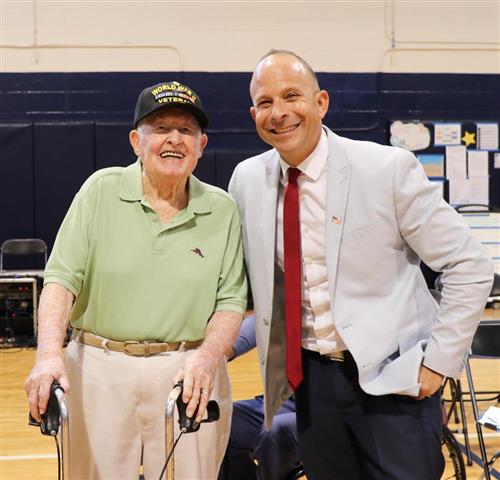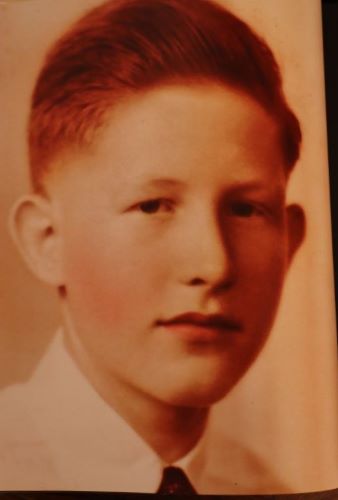Together PCS
Page Navigation
Celebrating a century of wisdom: Longtime educator reflects on a life well lived
Longtime educator Dr. Robert Moore doesn’t have any tips for living a long life. But he does have a recipe for living a fulfilling one: Be kind, have fun and connect every day with family and friends.
Moore will celebrate his 100th birthday in February. When asked about his advice for longevity, he laughed long and hard.
“My favorite things are donuts and Manhattans,” he said. “That’s not something that I would recommend for a long life, but it’s what I enjoy.”
Moore is a highly decorated World War II hero who has left a monumental legacy in Pinellas County Schools. He dedicated nearly 35 years to the district as a teacher, a principal and a School Board member.
Moore was Madeira Beach Elementary’s first principal. He was invited back to the campus in November for a Veterans Day celebration. An educator at heart, Moore made sure to incorporate a lesson about the origin of Veterans Day during his speech. The children and current principal, Chris Ateek, treated him like a celebrity.
“I really have fond memories of Madeira Beach,” he said. “It was a pleasure for me to be invited back.”
After retiring several decades ago, Moore traveled the world with the love of his life, Marion. He also played golf and dabbled in watercolor painting.
Since his wife passed away, his social life has quieted down a bit. He enjoys spending time with family, chatting on the phone and writing emails to friends, including his former World War II tentmate, Mel Hodell, who is 102.
Last year, he tracked down four of his former high school classmates. They celebrated their 80th high school reunion via phone and Zoom.
From Shangri-La to World War II
Moore’s story began in Cincinnati on Feb. 23, 1924. He was born in the family home and grew up playing football, softball and marbles. Moore’s copper hair earned him the nickname “Red.” When he was 9, his sister Mary was born.
Moore started high school in 1938 and bought a 1927 Chevrolet for $18. He was just 14 years old. At the time, he was able to get an Ohio driver’s license. After some tinkering, he got the Chevy running and drove his friends to school.
He wasn’t sure what he wanted to do when he graduated, but he was leaning toward a career in business.
“Growing up in ‘39 and ’40, it was like growing up Shangri-La.” He remembers listening to the big bands, Glenn Miller and the Dorsey Brothers.
“Life was really great in my junior/senior year. And then, on December 7, it was like you flip a light switch off,” he said.
Everything changed. The U.S. entered the war after the Japanese attack on Pearl Harbor. Moore, who was studying business administration at Miami University in Ohio, enlisted in the Army Air Corps.
He was called into the Air Corps and became a Hump Pilot, flying ammunition, fuel and supplies to support U.S. allies. He battled monsoons and heavy storms during harrowing flights from India over the Himalayan Mountains to China.
“It was considered the worst flying weather in the world, but we had to do it,” Moore said.
More than 500 aircraft and more than 1,300 crewmen were lost during the Hump operations, according to military estimates.
Moore was so focused on his missions that he was rarely afraid. At least three times, he lost an engine over the Hump. One of his many close calls happened when he crashed during takeoff on a flight from China in May 1945.
He detailed the story in an article he wrote for his Hump Pilot military group: Moore was flying with two crewmen when his plane suddenly veered hard to the left. He tried to maneuver the plane, but it continued toward an embankment. He cut both engines and pushed hard on the brakes, but the plane crashed. The impact severed the gas line, and the plane burst into flames.
“The three of us, fearing the plane might explode, headed for the rear cargo door,” he wrote. “We jumped out and ran away from the plane.” There was no explosion, but the plane continued to burn until it was destroyed.
He returned the next day and took pictures of the wreckage. He kept a small piece of metal as a souvenir.
Moore continued to fly until a little after the war ended in the fall of 1945. His bravery awarded him the Distinguished Flying Cross, the Air Medal and the Asiatic Pacific Theater Ribbon with Two Battle Stars.
From Commerce to the Classroom
Moore returned to Ohio with plans to complete his education and hopes of meeting a nice girl.
First, he earned a bachelor’s degree in commerce from Salmon P. Chase College. Then, he decided to go a different direction. He took advantage of the GI Bill and earned a bachelor's degree in education from the University of Cincinnati.
“Immediately after the war, all of the school systems wanted to get some men back in the classroom. Jobs in education were plentiful and, as a man with a degree in education, you could almost pick your site and get a job teaching,” he said.
He was eager to date, but many of his high school classmates had married or moved away.
A friend fixed him up with a young woman named Marion. She had dark hair and brown eyes. Best of all, she was sharp.
“We hit it off right away,” Moore said. They got married in 1948, started their family and decided to leave Ohio.
Moore’s parents had moved to St. Petersburg, and Moore was interested in moving nearby. In 1950, he and his wife moved to Florida. Moore was hired to teach in Brooksville, and a year after that, he was hired at the “old” Largo Elementary by Principal Mildred Helms.
Moore later taught at Gulf Beaches and Azalea Elementary schools. He loved teaching, and his students could tell.
“He was my favorite elementary school teacher. There is no question about it. He cared for the kids and made us feel good,” recalls Dan Wagstaff, 79, one of Moore’s former fifth-grade students.
Teaching was in the family. Moore’s wife taught for more than 20 years at Azalea Middle School. His daughter Wendy and son Michael also became teachers.
A Legacy of Leadership
In 1957, Moore was hired as the first principal of Madeira Beach Elementary. He was promoted to principal of Madeira Beach Jr. High, but they didn’t have a principal for elementary school right away.
“For two years, I was the principal of both schools. My office was in a trailer on the parking lot behind the cafeteria,” he said.
In the third year, they hired a principal for the elementary school, and he transitioned full-time to the junior high, which became a middle school.
“I had a wonderful group of people to work with. I could have been happy just staying in that elementary school forever,” Moore said.
He enjoyed serving at the junior high, too. “That was an equally nice group of people,” he said. “The faculty socialized a lot,” occasionally grabbing a drink after work.
In 1981, after 24 years of serving as principal of Madeira Beach schools, he decided to retire. His salary at the time was $30,000 a year. He hoped to earn more.
“When I retired from the school system, I had my doctorate, and I was at the top of the pay scale for a junior high principal,” he said.
He accepted an offer from a company that installed computer systems in schools. His area included Florida, South Carolina, and Georgia.
He didn’t love traveling for work, but he stuck it out for four years. His daughter, Pamela, offered him a job running a hotel she and her husband built in Pensacola. She told him that running a hotel is a lot like being a principal.
He tried that, but he and his wife decided to return home to St. Pete after just a year.
“I still had school in my system, I guess,” he said. So, he decided to run for the School Board.
Moore was elected in 1986 and served as chairman from 1989 to 1990.
“I really got involved with the schools. I made a point to visit all of the schools. And I knew almost everybody because I had been principal so long,” Moore said.
In 1990, Moore was instrumental in appointing Superintendent Howard Hinesley, who served the district for 14 years.
“I liked Howard very much. I thought he would make a good superintendent,” Moore said.
Moore failed to win a runoff election and left the district at the end of 1990.
“My life was fulfilled just being active in education,” he said.
For a short time, Moore worked for Bryn-Alan Photography, helping them connect with elementary schools. After that, he really retired.
Still Seizing the Day
Moore relished the extra time he had to spend with family and friends. He and his wife traveled the world and visited all the national parks from Maine to Oregon. Their favorite trips were European river cruises. They hiked to the bottom of the Grand Canyon in their 50’s and snowmobiled through Yellowstone National Park in their late 70’s.
His son Michael passed away in 2007. And in the spring of 2021, Marion passed away. She was 96. Since then, Moore’s fast-paced life has slowed down.
“He and my mom were madly in love. They laughed all the time,” said Moore’s daughter Jennifer Kennard. “They always saw the bright side of things.”
Moore, who lives independently, still enjoys connecting with family and friends. In addition to his three daughters, he has two grandsons, two great-grandsons and one great-granddaughter. His daughter, Wendy Bloomer, is his local caregiver.
He’s closer than ever with his sister, Mary “Mickey” Eley, 91, who does his grocery shopping. They talk on the phone every day and visit several times a week.
“I am sure my parents would be flabbergasted to know he and I lived this long,” Eley said.
Moore has a positive outlook on life. He thinks it came from having a wonderful childhood and a loving family.
“Growing up, I had a happy childhood. My mom and dad were just perfect. My grandmas and grandpas, we visited them all the time,” he said.
His daughters are throwing a big party for him in February, and he’s looking forward to seeing his friends, family and former students, including some he taught almost seven decades ago.
“I am a little embarrassed that the girls are making such a big to-do of it,” he said.
But, he admitted, “It will be very nice to see so many people. Some people who are coming I met when they were 10 years old... I suppose they are approaching 80.”





